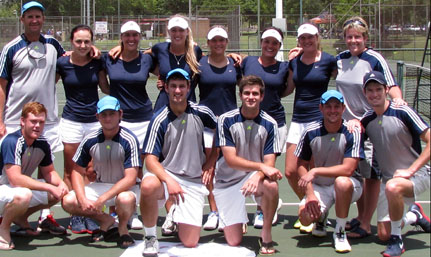 |
Members of Kovsies winning tennis team.
13 December 2012 |
For the sixth time in a row, the tennis team of the University of the Free State won gold at the tennis championships of the University Sports South Africa (USSA) tournament. The tournament was held from Monday 3 December 2012 until Friday 7 December 2012 at the University of Pretoria, where 21 teams from 20 tertiary academic institutions participated.
The team participated in a round robin during the first three days where they beat the University of KwaZulu-Natal, the University of Johannesburg, the Nelson Mandela Metropolitan University and North-West University (Potchefstroom Campus). On Thursday, the team played in the semi-finals against the University of Pretoria and won the tiebreak 8-2. Friday’s final was against the Stellenbosch University and after eight singles matches, Kovsies was already 8-0 up. There was thus no need to play the doubles and mixed matches.
After the USSA tournament, four Kovsie players were included in a training group to take part in training camps, tournaments and trials in preparation for the World Student Games (Universiade) in Russia in 2013. These four students are Duke Munro, Christi Potgieter, Elizna Barnard and Hendri Steyn. The coach and team manager of the Kovsie team, Marnus Kleinhans and Janine de Kock, were also appointed coach and manager of the South African Student team for the World Student Games.
At the Annual General Meeting of USSA Tennis, Janine de Kock was re-elected as chairperson and Marnus Kleinhans as technical advisor. The captain of Kovsies, Christi Potgieter was also selected as vice-chairperson.